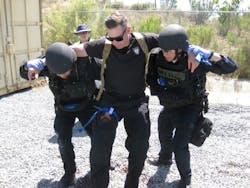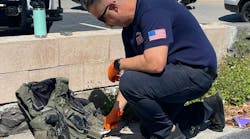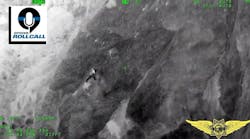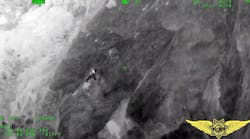In World Trade Center, NYPD Emergency Services Unit (ESU) Detective John Busching, a tactical medic, works to save the life of Port Authority Sergeant John McLoughlin, the last survivor removed from the rubble on 9/11. McLoughlin’s survival was due in part to the skill set, equipment and sheer determination of the dual-trained men who crawled into the hole to attend him. They were able to keep him alive for 19 hours before they could get him out. They established an IV, providing fluids and pain meds. McLoughlin’s legs were crushed and the men even contemplated amputation all while in a crawl space that only allowed front and back movement.
Fast forward to 2016 in San Diego where Donald Trump held a rally. The police department riot team embedded with specially trained Special Trauma and Rescue (STAR) members assisted during the event treating multiple patients and a lot of minor injuries. The team’s composition allowed them to support the first responders and the public. Although two very different scenarios, they both have one thing in common: both had tactical medics as part of the response.
TEMS and CONTOMS
Tactical medicine is not a new concept. In fact, it’s as old as war. Treating injuries in a combat zone has become common, increasing survivability. Thankfully, people recognized law enforcement, particularly special operations, could benefit from the same tactics. An incident in 1982 helped start integration when a disgruntled worker smashed his car through the front lobby of the IBM building in Bethesda (MD) and went on a shooting spree. With the suspect actively shooting and barricaded inside the building, officers and EMS personnel did all they could to locate and treat victims. A lot of lessons were learned and the incident was the catalyst for Tactical Emergency Services (TEMS), a standardized approach to medical care in a threat environment integrating medical care lessons learned in a military environment and law enforcement principles.
During this same time period another group of individuals determined similar conclusions. In 1989, the Counter Narcotics and Terrorism Operational Medical Support (CONTOMS) pilot program began as an initiative introducing Tactical Combat Casualty Care (TCCC) to civilian emergency medical professions. A cooperative effort between the U.S. Department of Defense (DOD) and the U.S. Park Police, CONTOMS was designed to “meet the need for specialized medical training to support law enforcement special operations.” These combat-proven medical best practices protect the protectors.
TEMS and Special Operations
TEMS and SWAT go hand in hand. In fact the National Tactical Officers Association (NTOA) began supporting TEMS in the early 1990s. “It’s not a bandwagon that we jumped on,” explains Mark E. Gibbons, TEMS Instructor, NTOA. Special operations are dangerous and if officers are doing something dangerous they need to plan for it, he says. Part of that planning is having trained tactical medics embedded in the team. NTOA recommends TEMS for all special operations teams. “These TEMS providers are capable of developing medical threat assessments, implementing risk reduction strategies, providing logistical support, coordinating operations with local emergency medical services (EMS), and rendering immediate medical care within the tactical environment of a law enforcement operation,” NTOA TEMS Position Statement outlines. NTOA also helps guide TEMS training.
TEMS training
A variety of resources exist for TEMS training and certification. Currently, the National Association of Emergency Medical Technicians (NAEMT) offers Tactical Emergency Casualty Care (TECC), a 16-hour course based on guidelines by the Committee on TECC (C-TECC) and the Tactical Combat Casualty Care (TCCC) program. CONTOMS offers an Emergency Medical Technician-Tactical (EMT-T) as a one week, 56-hour module for medical personnel supporting special operations. In addition to these and other courses offered by private organizations, the California Commission on Peace Officer Standards and Training (POST), the California Emergency Medical Services Authority (EMSA) and the International School of Tactical Medicine (ISTM) have the only federally approved tactical medic program in the United States. The ISTM modules, as well as the Law Enforcement Tactical Lifesaver course have also been approved by the Department of Homeland Security (DHS).
Along with medical, TEMS members attend law enforcement training. The STAR team goes through the same SWAT recruitment officers do minus the shooting portion. After recruitment, they attend a 3-day mini-academy after which they are issued their gear. “When it’s available, we send them through the 40-hour CCC training,” explains Chris Webber, Deputy Chief, Special Operations. “As it is available, they go through the SWAT academy which is only run every few years. So they may have to wait three years to be fully trained.” The NTOA also recommends core competencies a TEMS provider needs to have.
Outside the classroom
Once the medical and law enforcement portion of the training are complete, they are far from done. NTOA recommends they be fully integrated into the special operations team. “That TEMS unit should be training (with) and getting the trust of that tactical unit and vice versa,” says Matthew Simonetti, Detective-Corporal/Tactical Medic, Summerville (SC) Police Department. “Any classes that a unit (attends), TEMS should be part of.” Gibbons concurs stating special operation incidents are chaotic and unpredictable, therefore teams must train repeatedly in order to perform when needed. An important element of a successful TEMS program is this culture of integration. “While we think big, TEMS providers need to be integrated into all phases from training and planning as well as execution,” says Gibbons. “That helps create a culture within the organization that tactical medics are an integral part of the team and they’re with you at every turn.
A Medic with tactical training or an officer with medical training?
Many different models exist. Gibbons points out there is no one-size-fits-all TEMS configuration. One model is to take an officer and give them medical training.
Simonetti is an officer and an EMT. After discharging as a Navy Corpsman, he pursued law enforcement but he didn’t leave his EMS side behind. After a murder-suicide where EMS refused to go in because the scene wasn’t secure, a number of officers on Simonetti’s department began questioning what would happen if one of them got injured. In response, he started a TEMS unit. When he left and joined Summerville, he began their program in 2005. Along with him, Simonetti’s team includes three full-time county paramedics who went through a special school to become volunteer police reserves. “A lot of guys are coming back from overseas and they already have this mindset for combat medicine and it’s being transferred over to the civilian side,” Simonetti explains. He sees TEMS becoming more common place. Although he falls into the officer with medical training model, he sees the benefits of the other side. “It is easier to train a medic into an operator than vice versa,” he explains. San Diego agreed going with the medic with tactical training model.
In June 1981 in Linda Vista (Calif.), a neighbor dispute ended in the death of two San Diego police officers. It was the catalyst for the department’s SWAT team as well as the STAR team. At the time San Diego contracted with a private ambulance company so the team was made up of some of these paramedics. In 1996, the fire department took over the contract and the STAR team hiring many of the current medics. This model made sense due to the training curve on medic skills. “It would be hard for a police officer to keep up those skills to a medic level,” says Webber. “We can give people SWAT training which is easier to keep up. Our STAR guys don’t carry weapons. They are strictly in a medic roll. They don’t keep up the shooting skills. They keep up their medic skills.”
Conflicting missions
It’s no secret that police and EMS often have conflicting missions. Can a provider who took an oath to Do No Harm step over a critically injured person and continue on to find the threat? Yes. Tactical medics look at the larger goal of stopping the creation of more injuries. “While they have different skill sets and responsibilities, their mission is the same and that’s to save lives,” says Gibbons. “The merger of the two disciplines can be accomplished using best practices of medicine, tactics and, above all, leadership.” Dennis Krebs, a former tactical medic and author of Medic Up: Where Criminals, SWAT Teams & Medicine Intersect states, “The saying in military medicine and tactical EMS is that, ‘good medicine can sometimes be bad tactics and bad tactics can get everyone killed.’ The medic assigned to a team must clearly understand that his responsibility to treat the injured may not always be congruous with the SWAT team’s mission.”
Whichever model an agency chooses, what won’t work is stand-by with generic EMS units. “Agencies must access their available resources to determine how best to support special operations with officer medical care,” explains Gibbons. “There are many models and none are the best. Each one needs to be custom fit to each agency. What model doesn’t work is putting an ambulance on the corner and expecting them to support your tactical operations.”
Not just the biggies
The discussion of TEMS really hit a fevered pitch in light of active shooter incidents. When people are hurt and dying, everyone questions why EMS isn’t going in and treating the wounded. Although the topic of many jokes, as well as heated arguments, regular EMS are neither trained, nor equipped to enter a non-secure, hostile environment. These incidents, including the recent Orlando nightclub shooting have people screaming for more tactical medics and the discussion leads to more TEMS providers even if the main purpose of TEMS is much less flashy. “It’s important to understand that TEMS is a spoke in the wheel of a response,” explains Gibbons. TEMS teams have a primary roll of responding with special operations to ensure the health and well-being of law enforcement, as well as innocent civilians. “TEMS responsibilities are to support law enforcement special operations which can range from executive protection details, civil unrest, street level narcotics arrests, and austere missions all the way to high-risk warrant service and barricaded subjects,” explains Gibbons. In San Diego there are three levels of SWAT call-out. “We send the same response to any of them,” Webber says. “They get two STAR medics. When the call goes out, we pull them off the fire engine. We have a dedicated STAR team ambulance. One of them has to pick it up and take it to the scene. It’s dedicated to the first responders.”
Not an option but a standard of care
“I see it as a growing trend,” says Webber. “In Southern California, almost all areas have programs.” Gibbons explains that TEMS not only reduces injuries but also agency liability. “If you do something dangerous and you don’t plan for it you could be accused of deliberate indifference. We need to plan for it. What a tactical medic provides them is the insulation against undue negative press from the public, negative impact on a budget from a lawsuit and apathy among employees that a standard exists and we failed to meet those standards. TEMS is no longer an option for special operations law enforcement.” Simonetti agrees, “You’re doing your operators and your teams an injustice if you don’t have some type of injury prevention. You have to have that medical element there.” Gibbons reminds that TEMS is not EMS. “It is an extension of EMS,” he states. “It allows your agency to be more efficient and pro-active.” On game day, it saves lives.



